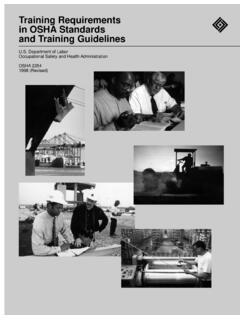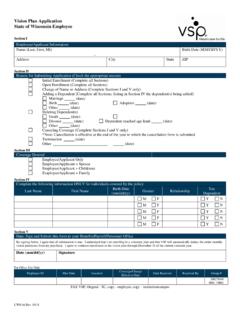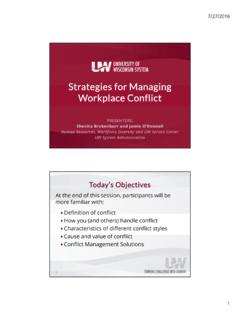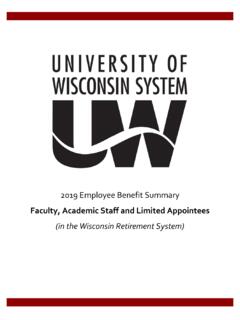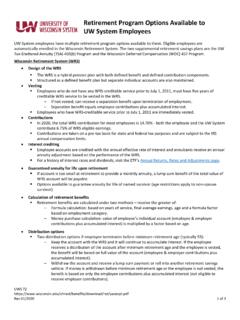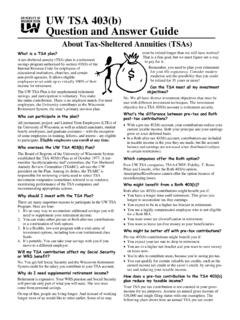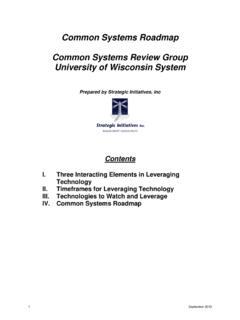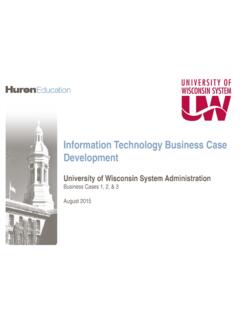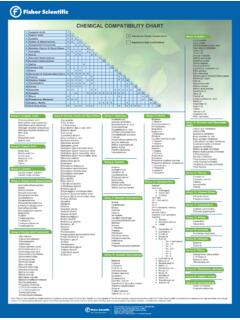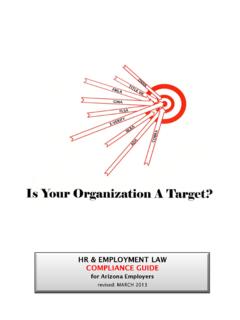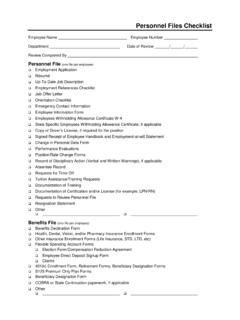Transcription of OSHA Recordkeeping Handbook
1 OSHAR ecordkeeping HandbookThe Regulation and Related Interpretations for Recording and Reporting Occupational Injuries and Illnesses 3245-09R 2005 Employers are responsible for providing a safe andhealthful workplace for their employees. osha srole is to assure the safety and health of America sworkers by setting and enforcing standards; provid-ing training, outreach and education; establishingpartnerships; and encouraging continual improve-ment in workplace safety and health. For moreinformation, visit Handbook provides a general overview of aparticular topic related to osha regulation.
2 It doesnot alter or determine compliance responsibilitiesin osha standards or the Occupational Safety andHealth Act of 1970. Because interpretations andenforcement policy may change over time, youshould consult current osha administrative inter-pretations and decisions by the OccupationalSafety and Health Review Commission and theCourts for additional guidance on osha compli-ance publication is in the public domain and maybe reproduced, fully or partially, without permis-sion. Source credit is requested but not information is available to sensory impairedindividuals upon request. Voice phone: (202) 693-1999; teletypewriter (TTY) number: (877) e Re gula tion and Rela ted Inte rpre tat ions fo r Reco rdin gan d Rep ort ing Occupati onal In jur ies an d Ill nessesOccupat iona l Safet y and He alt h Admi nis tra tionU.
3 S. Dep ar tm ent of Labo rDirectorateofEvaluationandAnalysisOffic eofStatisticalAnalysisOSHA3245-03R2006 This osha Web-based Recordkeeping Handbookis a compendium of existing agency-approvedrecordkeeping materials, including the regulatorytext from the 2001 final rule on Occupational Injuryand Illness Recording and Reporting Requirements( the Recordkeeping rule ) and relevant explana-tory excerpts from the preamble to the rule; chap-ter 5 of the agency's Recordkeeping Policies andProcedures Manual; Frequently Asked Questions(FAQs); and osha letters of interpretation. ThisWeb-based Handbook is intended to be a resourcefor businesses of all sizes, as well as osha 's com-pliance safety and health officers, complianceassistance specialists, and osha State-plans.
4 Theinformation in the Handbook is accessible bymeans of a user-friendly search engine that relieson simple point-and-click technology. The hand-book is designed to answer Recordkeeping ques-tions raised by employers, employees, and mem-bers of the osha family who are familiar with thebasic requirements of the rule but wish to obtainadditional information on specific recordkeepingissues. Users will also find the Handbook usefulas a research and training tool. The Handbook canbe accessed through the link below, which directsusers to the file. Because the Handbook is Web-based, it will be possible to update letters of inter-pretation and add FAQs to the file quickly as newquestions about the rule are raised.
5 IiiOSHA Recordkeeping Handbook IntroductionOSHA Recordkeeping Handbook ivThe Occupational Safety and Health Act of 1970(OSHAct) requires covered employers to prepare andmaintain records of occupational injuries and illness-es. The Occupational Safety and Health Administra-tion ( osha ) in the Department of Labor is re-sponsible for administering the Recordkeeping sys-tem established by the Act. The OSH Act and record-keeping regulations in 29 CFR 1904 and 1952 providespecific recording and reporting requirements whichcomprise the framework for the nationwide occupa-tional safety and health recording this system, it is essential that data recordedby employers be uniform and accurate to assure theconsistency and validity of the statistical data whichis used by osha for many purposes, includinginspection targeting, performance measurementunder the Government Performance and Results Act(GPRA), standards development, resource allocation,Voluntary Protection Program (VPP)
6 Eligibility, and"low-hazard" industry exemptions. The data also aidemployers, employees and compliance officers inanalyzing the safety and health environment at theemployer s establishment and is the source ofinformation for the osha Data Initiative (ODI) andthe Bureau of Labor Statistics (BLS) Annual January 2001, osha issued a final rule revisingthe 1904 and 1952 Occupational Injury and IllnessRecording and Reporting Requirements (Record-keeping) regulations, the first revision since goals of the revision were to simplify the sys-tem, clarify ongoing concepts, produce more usefulinformation and better utilize modern new regulation took effect on January 1, part of osha s extended outreach efforts, theagency also produced a Recordkeeping Policies andProcedures Manual(CPL , December 30, 2004),which contained, along with other related informa-tion, a variety of Frequently Asked Questions.
7 Inaddition, in 2002, a detailed Injury and IllnessRecordkeeping website was established containinglinks to helpful resources related to Recordkeeping ,including training presentations, applicable FederalRegister notices, and osha s Recordkeeping -relatedLetters of Interpretation. (See ).This publication brings together relevant informationfrom the Recordkeeping rule, the policies and proce-dures manual and the website. It is organized by reg-ulatory section and contains the specific final regula-tory language, selected excerpts from the relevantOSHA decision analysis contained in the preamble tothe final rule, along with Recordkeeping -relatedFrequently Asked Questions and osha s enforce-ment guidance presented in the agency s Letters ofInterpretation.
8 The user will find this informationuseful in understanding the Recordkeeping require-ments and will be able to easily locate a variety ofspecific and necessary information pertaining toeach section of the information included here deals only with therequirements of the Occupational Safety and HealthAct of 1970and Parts 1904 and 1952 of Title 29, Codeof Federal Regulations, for recording and reportingoccupational injuries and illnesses. Some employersmay be subject to additional Recordkeeping andreporting requirements not covered in this docu-ment. Many specific osha standards and regula-tions have additional requirements for the mainte-nance and retention of records for medical surveil-lance, exposure monitoring, inspections, and otheractivities and incidents relevant to occupational safe-ty and health, and for the reporting of certain infor-mation to employees and to osha .
9 For informationon these requirements, which are not covered in thispublication, employers should refer directly to theOSHA standards or regulations, consult osha s web-site for additional information ( ), orcontact their osha regional office or participatingState Recordkeeping and reporting questions not cov-ered in this publication, employers may contact theirOSHA regional office or the participating Stateagency serving their HandbookRoadmapviSection DISCUSSION1 FREQUENTLY ASKED QUESTIONS2 LETTERS OF INTERPRETATION2 Section exemption for employerswith 10 or fewer employees3 REGULATION3 PREAMBLE DISCUSSION 3 FREQUENTLY ASKED QUESTIONS4 LETTERS OF INTERPRETATION4 Section Partial exemption for establish-ments in certain industries5 REGULATION5 PREAMBLE DISCUSSION6 FREQUENTLY ASKED QUESTIONS9 LETTERS OF INTERPRETATION9 Section Keeping records for more than one agency10 REGULATION10 PREAMBLE DISCUSSION10
10 FREQUENTLY ASKED QUESTIONS10 LETTERS OF INTERPRETATION10 Section Recording criteria11 REGULATION11 PREAMBLE DISCUSSION12 FREQUENTLY ASKED QUESTIONS12 LETTERS OF INTERPRETATION12 Section Determination of work-relatedness13 REGULATION13 PREAMBLE DISCUSSION15 FREQUENTLY ASKED QUESTIONS22 LETTERS OF INTERPRETATION25 ContentsSection Determination of new cases37 REGULATION37 PREAMBLE DISCUSSION37 FREQUENTLY ASKED QUESTIONS41 LETTERS OF INTERPRETATION42 Section recording criteria47 REGULATION47 PREAMBLE DISCUSSION51 FREQUENTLY ASKED QUESTIONS78 LETTERS OF INTERPRETATION78 Section criteria for needlestick and sharps injuries75 REGULATION75 PREAMBLE DISCUSSION75 FREQUENTLY ASKED QUESTIONS78 LETTERS OF INTERPRETATION78 Section criteria for cases involving medical removal under osha standards79 REGULATION79 PREAMBLE DISCUSSION79 FREQUENTLY ASKED QUESTIONS80 LETTERS OF INTERPRETATION80 Section criteria for cases involving occupationalhearing loss81 REGULATION81 PREAMBLE DISCUSSION82 FREQUENTLY ASKED QUESTIONS92 LETTERS OF INTERPRETATION92 Section criteria for work-related tuberculosis cases96 REGULATION96 PREAMBLE DISCUSSION96 FREQUENTLY ASKED QUESTIONS98 LETTERS OF
